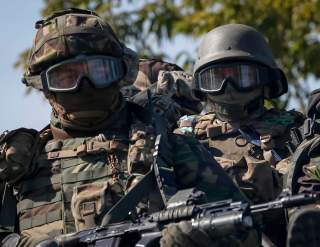Russia's APS Spetsnaz Rifle Can Fire Underwater, But How Good Is It?
We take a look.
Key point: The APS is so specialized for underwater use it is not a very good land weapon.
The widespread use of combat divers, more commonly known as frogmen, led to the inevitable question: how do frogmen from opposing sides kill each other when they meet underwater? In response, during the 1970s the Soviet Union developed an underwater assault rifle, the APS, that is still used by Russia today. The unusual-looking weapon is so uniquely suited to fighting under the surface of the waves it rapidly degrades if used on land.
The Soviet Union deployed large numbers of Spetsnaz commandos during the Cold War, direct action special forces troops with the mission of conducting deep strikes, diversionary operations, sabotage, assassinations and other operations in the event of war with NATO. The USSR had one Spetsnaz brigade of 900 to 2,000 troops for each of its fourteen military districts, plus an extra independent Spetsnaz brigade and air assault battalion.
Spetsnaz troops were trained to infiltrate enemy territory over land, air and sea to reach their targets. Many of the target countries, including non-NATO nations as Finland, Sweden, and Japan, had long coastlines and were thus highly vulnerable to infiltration by enemy frogmen. The Soviet Union had a variety of mini-submarines that could operate in littoral regions, detaching themselves from mother submarines and quietly unloading frogmen off enemy coastlines.
Soviet frogmen needed a weapon to ensure they could neutralize enemy frogmen underwater to complete their missions. Contrary to common perception, regular guns can indeed fire underwater. The main problem is that they are horribly inaccurate and their range is severely degraded passing through water. While frogmen still do carry conventional firearms, they are limited to combat on dry land. A handheld knife is a weapon that always works underwater, but the Soviets wanted a weapon that would overmatch anything an enemy frogman would carry to ensure their divers would go onto accomplish their mission.
The Institute of Precise Mechanical Engineering in Izhevsk was given the task of designing an underwater firearm, and the result was the APS underwater assault rifle. Designed by Vladimir Simonov, the APS uses a gas piston like its land brethren of the time, the AK-74 assault rifle. Unlike the AK-74, it fires from an open bolt position to allow the barrel to fill with water. This is necessary to allow the ammunition to operate properly.
The ammunition consists of 120-millimeter long 5.66-millimeter diameter steel bolts. The bolt uses the AK-74’s 5.45-millimeter casing but waterproof. Once fired, the bolt travels underwater in an air pocket created by the bolt’s flat nose, a process known as supercavitation. This, rather than the rifling of traditional guns, introduces stability to the round and some level of accuracy. The APS is fed from external box magazines holding twenty-six rounds each.
The APS is a select fire weapon, firing both semi-automatic and fully automatic, the latter at a rate of 600 rounds per minute on land. The rifle has a lethal range of about 100 yards on land. Underwater effective range varies due to the effect of pressure on the round. At 15 feet underwater it is thought to have an effective range of about 909 feet. At 140 feet underwater, the APS’ maximum range is thought to be no more than thirty-six feet. The weapon has a self-adjusting gas system to ensure operation at various depths and to make sure the owner doesn’t have to constantly manually adjust as he swims into deeper or shallower water.
The APS is a compact 24.17 inches with buttstock folded and 32.4 inches long with buttstock extended. Unloaded, it weighs a svelte five pounds, seven ounces. The barrel is 11.8 inches. Muzzle velocity for the 5.66 bolts is 1197 feet per second in the air.
The APS is so specialized for underwater use it is not a very good land weapon. The lack of rifled barrel stabilization makes it inaccurate, with one source estimating useful accuracy is limited to just 50 yards—less than a quarter that of land assault rifles. Using the weapon on land also induces rapid wear of parts, as the weapon is used to water slowing down and buffering operation.
The APS is an older design likely out of production, and Russia is reportedly seeking a replacement weapon. Meanwhile, the United States has never fielded an underwater assault rifle. This difference in priorities is a curious mismatch for two countries that maintain large numbers of SEALs/Spetsnaz/frogmen. Until such a replacement is fielded, the APS will continue to make Russian combat swimmers formidable adversaries underwater.
Kyle Mizokami is a writer based in San Francisco who has appeared in The Diplomat, Foreign Policy, War is Boring and The Daily Beast. In 2009 he co-founded the defense and security blog Japan Security Watch. This appeared last year.
Image: Reuters.

